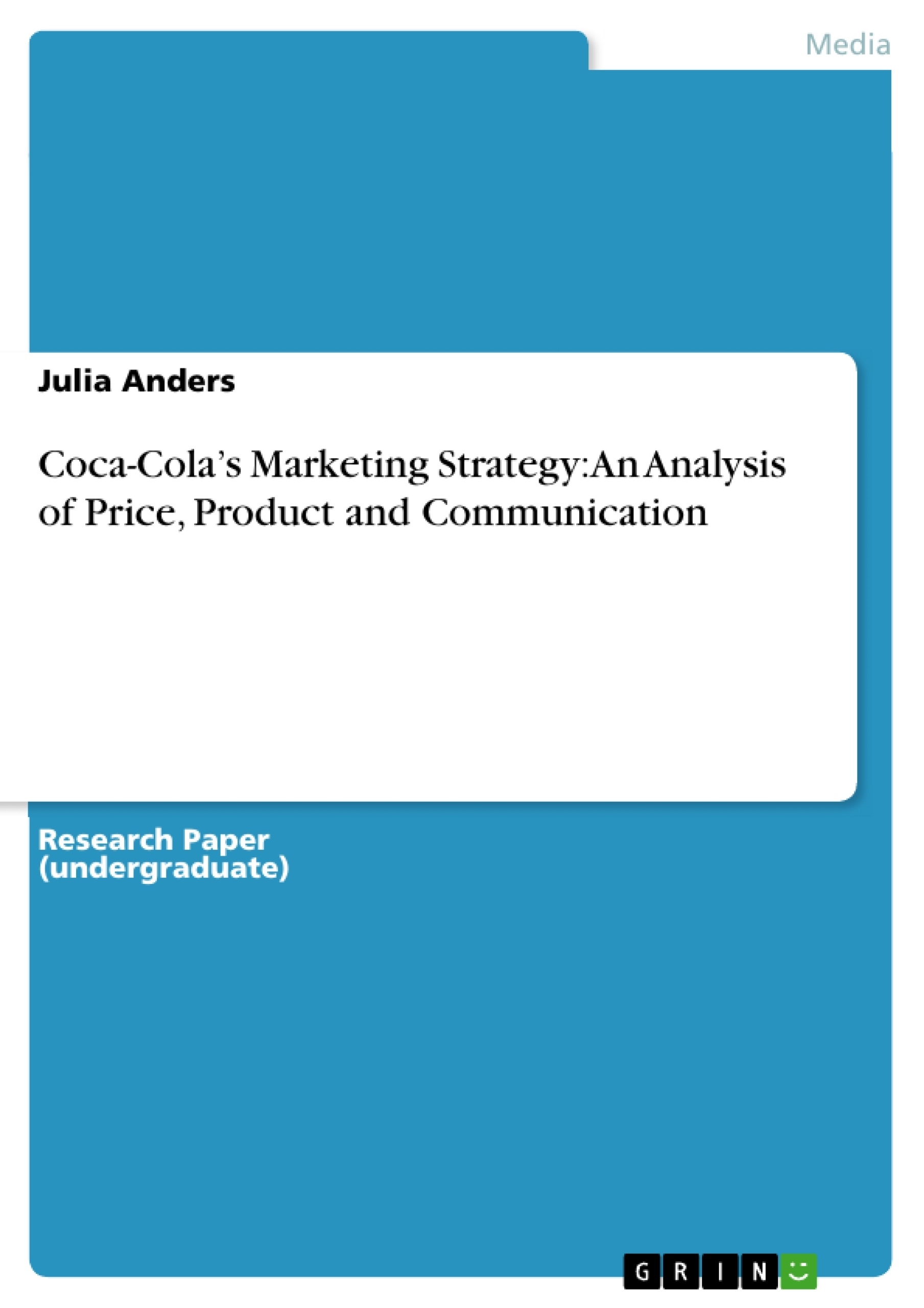Coca-Cola: a Soft drink which is not only refreshment, but an American symbol.
Coca-Cola has grown to one of the world’s biggest and most successful companies.
Such a success could only be achieved by a strong and outstanding Marketing Management.
Coca–Cola connects with its audience and customers in a way that other companies don’t do.
This report provides information about Coca–Cola’s Marketing Strategy and analyzes its
communication, product and price policy.
Table of Contents
- Executive Summary
- The Company's History and Birth of Coca-Cola
- Coca-Cola's Marketing Strategy
- Market Segmentation
- Mass Marketing vs. Targeted Marketing
- Geographical Segmentation
- Gender
- PEST-Analysis
- Porter's Five Forces
- SWOT-Analysis
- Marketing strategy and Marketing M
- Product and Pricing Policy
- Communication policy
- Communication Strategy
- Summary of the Main Results
- Main results of the price, product and communication policy
- Main recommendations
Objectives and Key Themes
This report aims to analyze Coca-Cola's marketing strategy, focusing on its communication, product, and pricing policies. The analysis seeks to understand the factors contributing to Coca-Cola's global success.
- Coca-Cola's historical development and its impact on its marketing strategies.
- An examination of Coca-Cola's market segmentation and competitive landscape.
- Analysis of Coca-Cola's product and pricing strategies.
- Evaluation of Coca-Cola's communication and advertising approaches.
- Assessment of the overall effectiveness of Coca-Cola's marketing strategy.
Chapter Summaries
Executive Summary: This section provides a brief overview of Coca-Cola's remarkable success and its reliance on a robust marketing strategy. It highlights the report's focus on analyzing the company's communication, product, and pricing policies, emphasizing their role in building a globally recognized and beloved brand.
The Company's History and Birth of Coca-Cola: This chapter details the origins of Coca-Cola, tracing its invention by John Pemberton in 1886 and subsequent acquisition by Asa Candler. It emphasizes the crucial role of early marketing strategies, particularly Candler's aggressive approach, in establishing Coca-Cola's popularity throughout the United States and Canada. The chapter also highlights the evolution of the brand's image and its initial use of cocaine, ending with its present-day global consumption.
Coca-Cola's Marketing Strategy: This chapter lays the groundwork for the subsequent analysis by defining a marketing strategy and highlighting Coca-Cola's success as a prime example of effective marketing. It emphasizes the importance of thorough analysis in building a strong strategy.
Keywords
Coca-Cola, marketing strategy, brand building, market segmentation, product policy, pricing strategy, communication policy, advertising, public relations, PEST analysis, Porter's Five Forces, SWOT analysis, global marketing, brand management.
Coca-Cola Marketing Strategy Report: Frequently Asked Questions
What does this report cover?
This report provides a comprehensive analysis of Coca-Cola's marketing strategy. It includes a table of contents, objectives and key themes, chapter summaries, and keywords. The report delves into Coca-Cola's history, its market segmentation, product and pricing policies, communication strategies, and overall effectiveness in building a globally recognized brand.
What are the key themes explored in the report?
The report explores Coca-Cola's historical development and its influence on marketing strategies, examines its market segmentation and competitive landscape, analyzes its product and pricing strategies, evaluates its communication and advertising approaches, and assesses the overall effectiveness of its marketing strategy.
What specific marketing aspects are analyzed?
The report specifically analyzes Coca-Cola's communication, product, and pricing policies. This includes examining market segmentation (geographical, gender), PEST analysis, Porter's Five Forces, SWOT analysis, and the overall impact of these policies on Coca-Cola's global success.
What is the historical context provided in the report?
The report traces Coca-Cola's origins from its invention in 1886 to its present-day global presence. It highlights the crucial role of early marketing strategies in establishing its popularity and the evolution of the brand's image over time.
What analytical frameworks are used in the report?
The report utilizes several analytical frameworks, including PEST analysis, Porter's Five Forces, and SWOT analysis, to provide a comprehensive evaluation of Coca-Cola's marketing environment and competitive positioning.
What are the main findings or recommendations (as summarized)?
The report's main findings and recommendations are summarized in dedicated sections, highlighting the key results of Coca-Cola's price, product, and communication policies, and offering suggestions for future strategies. Specific details are found within the report's individual chapters.
What are the keywords associated with this report?
The keywords associated with this report include: Coca-Cola, marketing strategy, brand building, market segmentation, product policy, pricing strategy, communication policy, advertising, public relations, PEST analysis, Porter's Five Forces, SWOT analysis, global marketing, and brand management.
What is the overall objective of this report?
The main objective is to analyze Coca-Cola's marketing strategy to understand the factors that have contributed to its global success. It aims to provide insights into the effectiveness of its communication, product, and pricing policies.
- Quote paper
- Julia Anders (Author), 2011, Coca-Cola’s Marketing Strategy: An Analysis of Price, Product and Communication, Munich, GRIN Verlag, https://www.grin.com/document/232661



